BIOGRAPHY CARDS

The biography cards provided an insight into my CLD student' current level of Second Language Acquisition. I aligned my students' WIDA Access Scores with the language in context chart. I determined where the students fell in regard to their SLA and the WIDA Can Do Descriptors. After extensive evaluation, I determined that one of my students may have an affective filter that is blocking his acquisition of an L2. According to Krashen's theory, "his affective filter hypothesis, learners, because of motivation, anxiety, or stress, can put up an affective filter that blocks the internalization of comprehensible input surrounding them and thus the acquisition of an L2" (Valdés, 2011, Realistic Expectations p. 20). After discovering this possibility, I shared with my mentor the possibility that this student's way of learning a second language needed to focus on input rather than grammatical instruction. For my other students, conducting the biography cards built upon the second level of the accommodation readiness spiral; readiness for CLD Students and Families. As a teacher recognizing my students' funds of knowledge places value on the learner's culture. Described by Maria Brisk, "the second level of the spiral highlights the teacher's readiness to recognize, explore, and maximize those resources, those funds of knowledge, [...] that CLD students and their immediate or extended family members may bring to the learning environment" (Brisk, 2008, p. 154). Bringing these funds of knowledge, learned from the students' biography cards, into the classroom gave me valuable insight into student' socio-psycholinguistic domains that helped me develop lesson plans. The lesson plans were targeted to utilize their strengths, develop their weak areas, and keep affective filters low.
As we have explored Biography-Driven Instruction, a major component of our lessons included conducting a biography card for our students. For each of my students, I learned their L1 and L2 proficiencies, preferred grouping for the classroom, hobbies or interests, home life, and goals in life. This was a great way to get to know each student and design instruction around their needs and interests.


Teachers who use biography cards in correlation with BDI demonstrate qualities of Teacher Quality Standard II. The standard states, "Teachers establish a safe, inclusive and respectful learning environment for a diverse population of students." Demonstrating a commitment and respect for diversity builds safety and trust between the students and teacher. Additionally, as teacher candidates, conducting biography cards and analyzing the information to inform instruction, we demonstrate skills that TESOL recognizes as Professionalism. Standard 5.a states, "Supporting Explanation. Candidates are familiar with the history of ESL teaching and stay current with recent research, methodologies, and strategies in the field. They use this knowledge to design effective instruction for ELLs." Demonstrating mastery of these standards outline the knowledge required for excellent teachers. As we work through to become effective teachers, reflecting on the standards required of us is a tool for success.